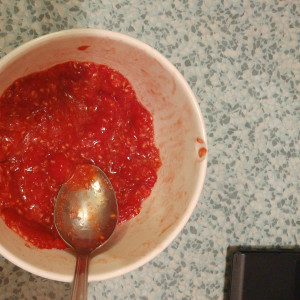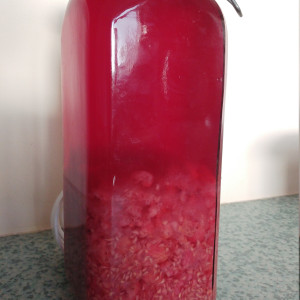Table of Contents
Preparation of Raspberry Vodka
Abstract
In this article, I present a method for extracting chemical compounds from raspberry using 37.5% food-grade ethanol-water solution commonly known as vodka, in order to prepare a drink known as raspberry vodka.
At a glance
Introduction
Saao went to Qfcasf over the weekend. She reported that her friends made some raspberry vodka and brought it along to the trip, which she absolutely enjoyed. That sounds really cool and fun. Personally, I love fruity drinks. One of my favourite drink is Pimms. (Although I don't know if that's because it evokes the memories of Qoapfwrus, especially Xizwob.)
I decided to make some raspberry vodka for my birthday, which is coming up very soon. I am sure I would love it, and Saao would probably love it too.
Anyway, the format of this article loosely follows this article in Nature Protocols 1). It was the first article on Nature Protcols' website. I used to be a proper scientist. I kind of miss being a proper scientist.
Theory behind the reaction
Vodka in EU contains a minimum of 37.5% ethanol. Ethanol is an interesting solvent. It is fully miscible with water. It has a polar hydroxyl (OH) group and a non-polar ethyl (C2H5) group. This means that it is capable of dissolving a wide range of polar and non-polar compound. Ethanol can be used to extract chlorophyll 2) - this is a reaction performed by A-Level biology students.
The chemicals that give fruits flavour tend to have non-polar functional groups. This means that quite often they are more soluble in ethanol. The process behind making raspberry vodka is basically the extraction of the chemical compounds from the cells of raspberry.
Development of the protocol
The protocol for the preparation of raspberry vodka loosely follows the recipe provided by BBC 3). However, I made some modification based on my understanding of biology and chemistry. I hope the fact that I am using my biology and chemistry knowledge would make my science teachers from the past proud.
The original protocol calls for 500g of raspberries. I decided to go for 600g. This is because raspberries are sold in 200g boxes. The original protocol calls for 250g white caster sugar. I went for 250g icing sugar because my housemate left behind a 500g unopened bag of icing sugar. Icing sugar also dissolves more quickly.
I couldn't locate vanilla pods, so I substituted it with vanilla extract.
Due to the fact that my birthday is not far away. I would like to speed up the reaction. I decided to use mechanical disruption of cells in my protocol. I do note that there is a risk of increasing sugar content and acidity of the reaction mixture by releasing all the content of the fruit body. However, I like fruitier drink anyway.
Another way to speed up the reaction is by heating the reaction mixture under water bath. If you plug numbers into the Arrhenius equation, you would find that the reaction rate doubles for every 10 degree Celsius increase in temperature. The risk of this method is that some of the more unstable chemical compounds might decompose at a higher temperature. However, this should not be a concern, considering some protocols on the Internet call for a reaction time in the order of months.
Another concern regarding this reaction is bacterial growth. There is a report of ethanol being oxidised into ethanoic acid 4). Therefore I added heating the reaction mixture with a water bath filled with boiling water into my protocol, in order to control bacterial growth. It should be noted that the reaction mixture should not be heated using an open flame, as this creates a fire hazard. The hope is that I can achieve pasteurisation with this procedure. However, I am pretty sure the procedure I suggested would not achieve pasteurisation. I hope the high alcohol content and the exposure to slightly higher temperature is enough to deter bacterial growth.
Materials
Reagent
- 1 x 1 l Smirnoff Vodka
- 1 x 375 ml Smirnoff Vodka
- 1 x 500 g Silver Spoon Icing Sugar
- 1 x 75 ml Dr. Oetker Select Vanilla Extract with Seeds
- 3 x 200 g Co-op Raspberry
Equipment
- 1 x 1.5 l Preserving Jar (This container will be referred to as the reaction vessel)
- 1 x Cereal Bowl
- 1 x Spoon
- 1 x Funnel
- 1 x Strainer
- 1 x Washing-up bowl that is big enough to contain the preserving jar
- 1 x Saucepan
- Coffee filter paper
Procedure
Preparation of crushed raspberries
- Place 200 g of raspberries in the cereal bowl.
- Crush the raspberries using a spoon.
- Transfer the crushed raspberries into the reaction vessel.
- Repeat step 1-3 twice, in order to transfer all raspberries into the reaction vessel.
Preparation of the reaction mixture
- Transfer 250 g of icing sugar into the reaction vessel.
- Transfer all 75 ml of the vanilla extract into the reaction vessel.
- Transfer 1 l of vodka into the reaction vessel.
- Shake the reaction vessel vigorously, until the icing sugar is mostly dissolved.
- Top up the reaction vessel with more vodka.
- Seal the reaction vessel.
Heating of the reaction mixture
- Place the reaction vessel into the washing up bowl.
- Fill the washing up bowl with boiling water.
- Replace the water inside the washing up bowl with boiling water, when the water gets cold.
- Repeat step 1-3 when you are bored.
Storage of the reaction mixture
- The reaction mixture should be stored in warm places without light, to speed up the reaction.
- Once the raspberries turn pale pink, the reaction is considered as complete, as all pigments from the fruit bodies are extracted into the ethanol-water solution.
- The reaction mixture should then be stored in dark and warm places.
- The reaction mixture should then be filtered before use.
Filtration of the reaction mixture
- Place the strainer into the saucepan.
- Pour the reaction mixture through the strainer into the saucepan,
- Place funnel on top of the original vodka bottle.
- Place coffee filter paper inside the funnel.
- Gravity filtrate the reaction mixture and receive the final product into the vodka bottle.
Timing
- “Preparation of crushed raspberries” should take about 20 minutes.
- “Preparation of the reaction mixture” should take about 20 minutes.
- “Heating the reaction mixture” should take about 20 minutes.
- “Filtering of the reaction mixture” should take about 120 minutes.
Anticipated Results
- A tasty bottle of raspberry vodka.
- A lump of alcohol infused raspberry pulp.
Acknowledgement
I would like to thank Mr Knapp from my time in Ashmole School for teaching me GCSE Chemistry. I am pretty sure you introduced me to the Arrhenius Equation, even though the Internet suggests that it is something I learnt in A Level. I would like to also thank Mrs Sargent and Mr Frank for being great Biology teachers. I really enjoyed the chlorophyll extraction experiment and the DNA extraction experiment. I would like to thank Dr Kimberley Roper for being a great demonstrator and a great supervisor during my second year in Cambridge. I wasn't a great student, I didn't learn much, but I still find chemistry fascinating even to these days. I still find watching chemistry videos fun.
Finally, I would like to thank Saao, for being a great friend. I am definitely happier and more colourful because of you! 
Decryption hint: ΓΑΙΟΣ ΙΟΥΛΙΟΣ ΚΑΙΣΑΡ





